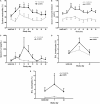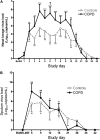Experimental rhinovirus infection as a human model of chronic obstructive pulmonary disease exacerbation
- PMID: 20889904
- PMCID: PMC3081284
- DOI: 10.1164/rccm.201006-0833OC
Experimental rhinovirus infection as a human model of chronic obstructive pulmonary disease exacerbation
Abstract
Rationale: Respiratory virus infections are associated with chronic obstructive pulmonary disease (COPD) exacerbations, but a causative relationship has not been proven. Studies of naturally occurring exacerbations are difficult and the mechanisms linking virus infection to exacerbations are poorly understood. We hypothesized that experimental rhinovirus infection in subjects with COPD would reproduce the features of naturally occurring COPD exacerbations and is a valid model of COPD exacerbations.
Objectives: To evaluate experimental rhinovirus infection as a model of COPD exacerbation and to investigate the mechanisms of virus-induced exacerbations.
Methods: We used experimental rhinovirus infection in 13 subjects with COPD and 13 nonobstructed control subjects to investigate clinical, physiologic, pathologic, and antiviral responses and relationships between virus load and these outcomes.
Measurements and main results: Clinical data; inflammatory mediators in blood, sputum, and bronchoalveolar lavage; and viral load in nasal lavage, sputum, and bronchoalveolar lavage were measured at baseline and after infection with rhinovirus 16. After rhinovirus infection subjects with COPD developed lower respiratory symptoms, airflow obstruction, and systemic and airway inflammation that were greater and more prolonged compared with the control group. Neutrophil markers in sputum related to clinical outcomes and virus load correlated with inflammatory markers. Virus load was higher and IFN production by bronchoalveolar lavage cells was impaired in the subjects with COPD.
Conclusions: We have developed a new model of COPD exacerbation that strongly supports a causal relationship between rhinovirus infection and COPD exacerbations. Impaired IFN production and neutrophilic inflammation may be important mechanisms in virus-induced COPD exacerbations.
Figures





Comment in
-
Human models of exacerbations of COPD: no extrapolation needed.Am J Respir Crit Care Med. 2011 Mar 15;183(6):691-2. doi: 10.1164/rccm.201009-1498ED. Am J Respir Crit Care Med. 2011. PMID: 21471063 No abstract available.
References
-
- Samet JM, Wipfli HL. Globe still in grip of addiction. Nature 2010;463:1020–1021. - PubMed
-
- Seemungal TA, Donaldson GC, Paul EA, Bestall JC, Jeffries DJ, Wedzicha JA. Effect of exacerbation on quality of life in patients with chronic obstructive pulmonary disease. Am J Respir Crit Care Med 1998;157:1418–1422. - PubMed
-
- Langsetmo L, Platt RW, Ernst P, Bourbeau J. Underreporting exacerbation of chronic obstructive pulmonary disease in a longitudinal cohort. Am J Respir Crit Care Med 2008;177:396–401. - PubMed
-
- Pauwels RA, Buist AS, Calverley PM, Jenkins CR, Hurd SS; GOLD Scientific Committee. Global strategy for the diagnosis, management, and prevention of chronic obstructive pulmonary disease: NHLBI/WHO Global Initiative for Chronic Obstructive Lung Disease (GOLD) Workshop summary. Am J Respir Crit Care Med 2001;163:1256–1276. - PubMed
Publication types
MeSH terms
Substances
Grants and funding
LinkOut - more resources
Full Text Sources
Other Literature Sources
Medical

